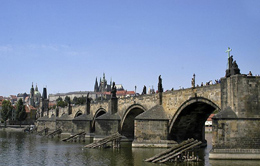
The repair of the outer shell of Charles Bridge could begin within two years
 |
"Heritage conservationists will examine each stone and issue a birth certificate, evaluating about 30 of its parameters. After the assessment, they will inform what will be done with each stone. Some will be replaced entirely, while in some cases, a part will be separated and replaced," Zemánek explained. According to him, the work will take about ten years, progressing arch by arch. However, the repairs will proceed from the underside of the bridge, so tourist traffic will not be disrupted in any way.
The most damaged arch over the Čertovka is currently covered from below with wood to prevent pieces of sandstone from falling off. However, according to Zemánek, it must be removed around Christmas, as the wood is already deteriorating. The bases of two statues, whose replicas are to return to the bridge, are also in poor condition. According to Zemánek, repairs will have to start with those.
Approximately ten years ago, waterproof insulation was laid on the bridge, which changed the water movement throughout the structure. Previously, builders allowed water to flow freely through the building, but due to the chemicals in the rainwater, salt, and chlorine, this was no longer possible, as it would damage the bridge. The insulation will prevent seepage. "The water that flowed there for decades, turning the bridge into a sponge, is gradually leaving. It evaporates through the walls and arches," Zemánek stated.
A new concrete slab has been created and insulation has been sprayed on. The railing was repaired using coarse sandstone, which some experts criticized due to its light color. "The entire shell, including the stones down to the riverbed, is original from various reconstructions," he added. The state of the bridge has also been affected by injections from the 1970s, as the cement mortar dries out the sandstone, thereby damaging it.
The problem with Charles Bridge, as well as with the Libeň Bridge and other Prague bridges, is warming and cooling. "In summer, they are heated by the sun but cooled from the inside. In winter, they are cooled from the outside and heated from the inside, which creates the greatest tension in the arch," Zemánek explained. The core of the bridge is not made of sandstone, but of broken tuff. However, the static condition of the bridge is very good.
Construction of the bridge began on July 9, 1357, at the instigation of Charles IV by stone master Otlín, who gained experience from building an older stone bridge in Roudnice nad Labem. "The founder of Charles Bridge was not Petr Parléř, as it is commonly believed. He was only 23 years old and did not have the right to build any structure in his name," Zemánek added. Parléř took over the construction only after Otlín's death.
Then the Stone Bridge, now known as Charles Bridge, was founded in the place of the demolished Judith Bridge. It stood on round stones similar to millstones. The facing wall was made of sandstone, while the core was made of broken Petřín tuff mixed with mortar. After the current repairs, all stones are being stored for future use. Currently, about 500 stones from the railing repair are in storage at Šutka, according to Zemánek.
The English translation is powered by AI tool. Switch to Czech to view the original text source.
0 comments
add comment
Related articles
0
07.06.2019 | Praha will replace the icebreakers that protect the pillars of the Charles Bridge
0
22.01.2019 | Prague wants to repair Charles Bridge, looking for a quarry with suitable stone
0
10.07.2017 | 660 years ago, the cornerstone of today's Charles Bridge was laid
0
21.10.2010 | The NPÚ does not consider the repair of Charles Bridge to be successful
0
20.10.2010 | The repair of the Charles Bridge is completed, inspection by the end of October
1
10.04.2010 | During the repair of Charles Bridge, 240 stones were crushed
0
06.04.2010 | The accusation against the official for the repair of Charles Bridge has been canceled
0
31.03.2010 | Due to the repair of Charles Bridge, the police charged director Kněžínka
0
12.08.2009 | Praha imposed a fine for the errors in the repair of Charles Bridge
0
20.11.2008 | <article>
Expert: The method of repairing Charles Bridge is wrong
</article>
0
06.02.2007 | The magistrate has two deposits of sandstone suitable for Charles Bridge
0
17.12.2006 | And after nearly 650 years, Charles Bridge hides many surprises
0
12.12.2006 | The magistrate announced a competition for the company that will repair the Charles Bridge










